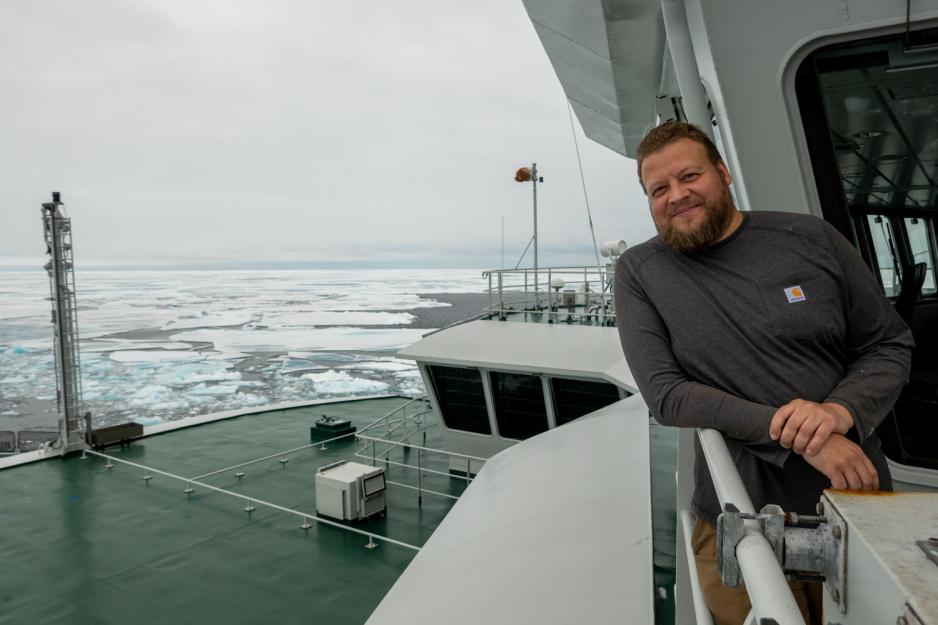Research Vessel Kronprins Haakon and Cruise Ship Le Commandant Charcot Team Up at North Pole

Le Commandant Charcot clearing a path through the ice for the Kronprins Haakon. (Source: Courtesy of Studio PONANT - Morgane Monneret)
Norwegian research vessel Kronprins Haakon and French ice-capable cruise ship Le Commandant Charcot joined forces sailing to the North Pole, creating a unique collaboration between scientific research and emerging polar tourism.
Kronprins Haakon departed Tromsø with 27 researchers and technicians on board on July 19 and arrived at the North Pole just 9 days later, encountering only limited ice, as part of its 2022 Arctic Expedition. The vessel met up with Le Commandant Charcot, a luxury ice-capable cruise ship, which also accommodates scientific researchers on board.
According to Ponant, the French company which operates the cruise ship, the two vessels’ captains coordinated the encounter ahead of time. In what is likely a first in the Arctic, the cruise ship opened up a channel in the ice and “escorted” the Haakon which followed behind en route to the pole.
“This collaboration is a unique opportunity for our guests to see first-hand the challenges involved in polar science. We are already discussing the possibility to continue to collaborate with the Kronprins Haakon once we have reached the geographic North Pole,” explained Captain Patrick Machesseau. Plans include for lead scientists and the Haakon’s Captain to come aboard the cruise ship to present on their scientific mission and research.
Kronprins Haakon’s Arctic Expedition is carried out under the auspices of the Norwegian Polar Institute and the University of Tromsø, which operate the vessel together with Havforskningsinstituttet, Norwegian Institute of Marine Research.
A rapidly changing ocean
As sea ice melts the Arctic seascape is rapidly changing, confirms Ole Arve Misund, expedition leader and director of the Norwegian Polar Institute. “The large open fields without ice surprised us. We had expected a dense ice cover, preferably with multi-seasonal ice (ice that has survived several summers without melting away). The Arctic Ocean is definitely changing.”
Just 10 years ago researchers could reach the North Pole during summer by plane which could land on temporary runways constructed on top of the ice. “The plane could land on the ice, which would be impossible today. Now the ice is not solid enough to carry out such flight operations, which is also a sign of the changes taking place here,” explains Mats Granskog a sea ice researcher at the Norwegian Polar Institute.

Sea ice researcher Mats Granskog and the other sea ice researchers observe the sea ice cover every three hours. (Source: Courtesy of Trine Lise Sviggum Helgerud, Norwegian Polar Institute)
Research to understand future challenges
The expedition will gather data on how climate change is affecting the area and how quickly the Arctic Ocean is transitioning from a white and ice-covered polar sea to a blue and open sea during summer. The ship’s scientists are taking environmental measurements and samples along the route and have deployed an autonomous ice station at the North Pole.
Scientists have long argued that the changes in the Arctic will have consequences for other parts of the world and will affect weather and climate outside the region. “There is a need for knowledge about how ocean currents, carbon cycles and fish migrations are affected in an ocean that will only be completely covered by ice in the winter, and no longer all year round," says lead researcher on board the Haakon, Paul Dodd.
“It is important for Norway to be present in the Arctic Ocean and monitor climate developments. With decreasing ice cover, large parts of the Arctic Ocean will become accessible all year round and the pole may in a few years become ice-free in autumn. In the long term, we will see increased activity around the North Pole, new transport routes, increased tourism and perhaps also fishing activity further north," concludes Misund.



